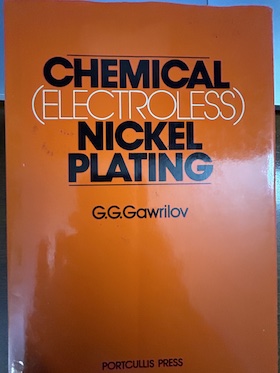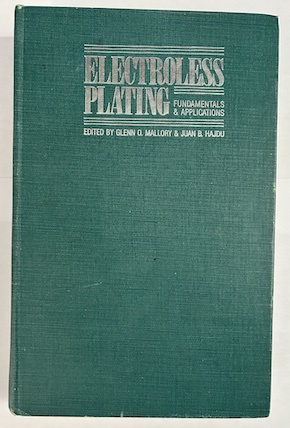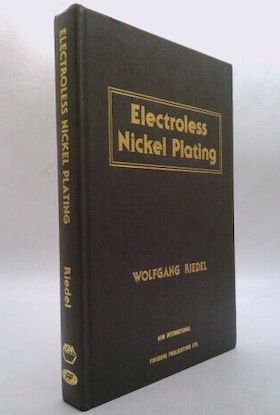
Curated with aloha by
Ted Mooney, P.E. RET

The authoritative public forum
for Metal Finishing 1989-2025

-----
Hardness of Electroless Nickel plating related to substrate hardness
Q. Hardness in EN deposits: Is the thickness of the deposit a factor for the as-plated hardness of Electroless Nickel? We plate mid-phosphorus nickel to 0.0005", is this enough deposit or do we have to go higher ? Thank you in advance.
Enrique Segovia- Monterrey N.L. Mexico
1999
A. The thickness of the nickel has no effect on the hardness on the nickel. But you get a problem using a gauge to control the hardness. Because you must go in beside on the nickel layer to receive a good result and that can be a problem with a thin nickel deposit. The hardness depends also if you use heat treatment after electroless nickel. Regard,

Anders Sundman
4th Generation Surface Engineering
Consultant - Arvika,
Sweden
1999
A. What hardness do you intend to get? The high phosphor EN has a higher hardness than mid phosphorous. Heat treatment increases hardness but decreases ability of the deposit to withstand NSS test.

Sara Michaeli
Tel-Aviv-Yafo, Israel
1999
A. Enrique, A mid-phos electroless should give about 38 to 42 Rockwell C as deposited. When trying to get any characteristic from an electroless bath, whether it be hardness, corrosion resistance or wear resistance, you should really be looking at a 1.0 thou or 1.0 mil thickness. Otherwise, you just get the hardness of the base metal. Ray
Ray Delorey- cambridge, ontario, canada
1999
Multiple threads merged: please forgive chronology errors and repetition 🙂
Electroless nickel plating with heat treatment for hardness up to 1100 HV
by G. G. Gawrilov

on AbeBooks
or eBay or
Amazon
(affil links)
Tip: Readers want to learn from Your Situation 🙂
(little can be learned from abstract questions, so many readers skip them)
1)WHAT IS THE REASON FOR POROSITY IN ELECTROLESS NICKEL PLATING?
2)WHICH IS THE BEST PHOSPHORUS CONTENT TO ACHIEVE HARDNESS 1100HV (HIGH, MEDIUM, LOW)?
3)WHAT IS THE BEST METHOD OF PLATING PROCESS TO ACHIEVE UNIFORM THICKNESS? MY TOLERANCE BAND IS 38 ±2 MICRONS?
- Bangalore, KARNATAKA, INDIA
A. Hi Ashwath. High phosphorous is best for high hardness, and readers can hopefully do a first cut at dispatching your questions in a paragraph or two. But please introduce yourself and your full situation because we have at least a dozen long threads on each of your questions and I have no clue which ones are most applicable for you yet; there are always countless ifs-ands-&-buts which it is impossible to discuss or warn against in the abstract. Real-world answers invariably require real-world situations. Thanks!
Luck & Regards,

Ted Mooney, P.E. RET
Striving to live Aloha
finishing.com - Pine Beach, New Jersey
2007
1-Reasons for porosity in EN. Too high surface tension, insufficient cleaning of substrate, substrate not uniform, previous micropores, suspended particles, chemical unbalance.
2-About hardness, 1100HV is at the top of the EN range and almost impossible to maintain batch after batch. 950-1050HV seems more realistic for heat treated high P deposits.
3-For thickness uniformity you need to avoid temperature stratification and maintain boundary layer uniformity which means good agitation and design of tank and auxiliary equipment.
Monterrey, NL, Mexico
January 2, 2008
ASHWATH NAGARAJ,
You want to know the reasons for porosity in electroless plated coatings. But you have not mentioned about your thickness.
I agree with Guillermo Marrufo. It is difficult to impart a hardness of 1100HV in EL Ni-high P coatings, even after heat-treatment.
You can achieve this level of hardness in EL Ni-P composite coatings incorporated with hard particles like, SiC, diamond, Si3N4, etc.
Borohydride-reduced electroless nickel plating may by another option.
Formation of uniform coatings is an important attribute of electroless plating as long as you maintain the bath parameters and operating conditions correctly.

T.S.N. Sankara Narayanan
- Chennai, Tamilnadu, India
(ed.note: The good doctor offers a fascinating blog, "Advancement in Science" )
Hardness of 1100 HV can be achieved with electroless nickel boron plating after heat treatment. As the process is electroless, uniformity is not a problem!
Makrand Kale- Pune, Maharashtra, India
April 19, 2008
Q, A, or Comment on THIS thread -or- Start a NEW Thread


